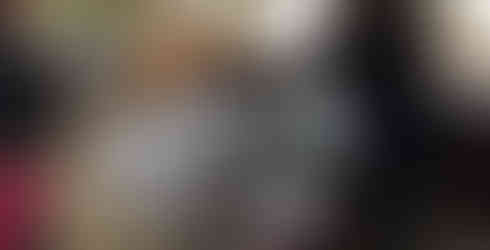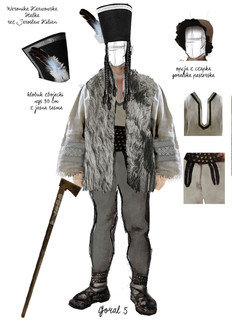Julia Brendel fabric designs showcased in the opera 'Halka' by Stanislaw Moniuszko
- by Julia Brendel
- Mar 16, 2017
- 4 min read
Last year I had the great pleasure to collaborate with The Grand Theatre in Lodz, Poland on a production of ‘Halka’, an opera by famous Polish composer, Stanislaw Moniuszko, directed by Jaroslaw Kilian.

'Halka', Highlanders
Photography. :: Katarzyna Ulanska, Costume design :: Weronika Karwowska, Director :: Jaroslaw Kilian
The occasion for this special production was the 50th anniversary of the Opera House in Lodz.
The premiere took place on the 21st January 2017.
'Halka' tells a dramatic story about a highlander girl who falls in love with a man above her social status who is engaged to be married to a noble lady. The action takes place in the Tatra Mountains in Poland.

Wedding scene
Photography :: Katarzyna Ulanska, Costume design :: Weronika Karwowska, Director :: Jaroslaw Kilian
Weronika found me through my Polish jacquard weaver and after seeing my fabric designs, decided that they would be perfect for her vision of highlanders’ costumes.
Over 2,000 metres of fabrics with patterns from our Memory and Arabica collections were jacquard woven on historical looms in Zyrardow, in Poland.

Press conference before the premiere
Photography :: HaWa, Costume design :: Weronika Karwowska, Director :: Jaroslaw Kilian
I was delighted to have the opportunity to collaborate on this project, mainly because of my personal nostalgia towards Poland. The inspiration for the fabric patterns used for the production came from my core passion for textiles, folk design and old craftsmanship.
Arabica and Memory fabric woven in Zyrardow Mills
Photography. :: Katarzyna Ulanska, Costume design :: Weronika Karwowska, Director :: Jaroslaw Kilian
I always find the process of creation the best part of any project. It is inspiring to see the level of skill of all the involved trades. From sketches, through choosing yarns for the cloth, the weaving process, to finally seeing designs materialising is absolutely magical!






Designs of highlander women and men costumes by Weronika Karwowska
A few words about the traditional folk costumes…
There were a huge variety of folk costumes in the Polish Tatra Moutains region and the patterns, embroidery and style would differ even from village to village. The folk costumes were worn on a day to day basis in some places right up to the second Word War. Even nowadays, it is not unusual to see men and women dressed in traditional clothes especially during folk festivals, weddings, religious holidays and in holiday spots to attract tourists.

Traditional Highlander's dance with 'ciupagi' - shepherd's axes.
Photography. :: Katarzyna Ulanska, Costume design :: Weronika Karwowska, Director :: Jaroslaw Kilian
A typical Highlander girl’s costume would consist of a white blouse, a vest that was embroidered and beaded on the front and back, a floral full skirt, an apron and a red coral bead necklace.
Arabica fabric used in men's costume on the sleeves and the collars and for makingwomen's skirts.
Photography. :: Katarzyna Ulanska, Costume design :: Weronika Karwowska, Director :: Jaroslaw Kilian
Weronika decided to use a more universal look. Although highlanders in her vision still wear costumes consisting of certain elements of regional recognition like beaded necklaces and wreaths, flowers in the girls’ hair and men carrying ciupagi (shepherd's axes, still used as a prop in many traditional dances), they are not faithful copies of the actual traditional costumes from the Podhale region.
They represent a more universal idea of what people from that part of the world and social class would wear, with only some traditional elements suggesting their origins.

Traditional Highlander's dance with 'ciupagi' - shepherd's axes
Photography. :: Katarzyna Ulanska, Costume design :: Weronika Karwowska, Director :: Jaroslaw Kilian
By using earthy colour pallet and raw linen cloth, the designer refers to a lower social class. She contrasts it with silky, pastel and shiny costumes interwoven with a golden thread in the nobles’ costumes.

First fittings
Photography. :: Katarzyna Ulanska, Costume design :: Weronika Karwowska, Director :: Jaroslaw Kilian

Dyeing Kierpce- traditional leather shoes and belts
Photography. :: Katarzyna Ulanska, Costume design :: Weronika Karwowska, Director :: Jaroslaw Kilian
All this hard work resulted in a spectacular show combining high-class music, dance, set design and of course the masterpiece of colourful costumes!

Highlanders
Photography. :: Katarzyna Ulanska, Costume design :: Weronika Karwowska, Director :: Jaroslaw Kilian

Weronika Karwowska
Born in 1980 in Łódź. She is a painter, stage and costume designer for film and theater productions. She graduated with honours from the Department of Scenography at the Academy of Fine Arts in Warsaw. She also completed postgraduate studies in Knowledge Culture at the Institute of Literary Research in Warsaw. In 2005 she was honored by the Theatre Institute in Warsaw for scenography and costume for a play "Purple Cow" in the Cane Factory in Warsaw. She has also designed sets and costumes for many tv commercials and the "South-North" movie, directed by her husband Łukasz Karwowski. Weronika cooperated with: New Theatre Praga in Fabryka Trzciny, Mazovian Music Theatre in Warsaw, 21 Theatre, Polish Theatre in Warsaw and Grand Theater National Opera in Warsaw.
Photography and graphic design also belong to Weronika’s artistic explorations.
Weronika developed her own programme of history of art for children and tought in Montessori primary school in Warsaw. She also led a theater workshop for mentally handicaped youth in Special School in Pruszków. This resulted in her painting project “I am” -12 potraits of pople with Down Syndrome.
Weronika participated in a few collective exhibitions in Poland and abroad (Prague, Moscow, Montreal) and had over ten individuals all over Poland. Lives in Warsaw. Weronika is a mum of five children.







































Comments